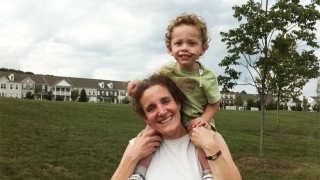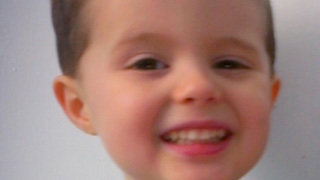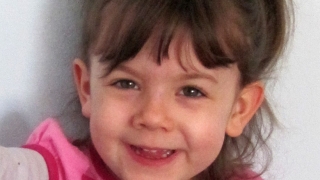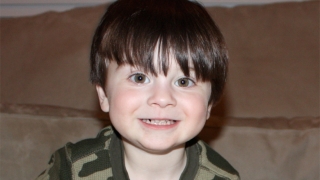Katharina Fachin Lucas, Aaron's mother, describes how the Pediatric Feeding and Swallowing Center at CHOP helped teach her young son to eat after a diagnosis of failure to thrive.
Aaron turned 2 during his first week in the Day Hospital Intensive Feeding Program at CHOP. It was the second week of school for his second grade and kindergarten-aged brothers. I had to drop them off at daycare and drive an hour into the city, only to watch my child be fed by someone else on his birthday.
And I would not have had it any other way.
Only four weeks later, Aaron could eat enough food to grow and thrive. Twelve months of nasogastric tube feedings were behind us.
Feeding tube at 10 months old
 I inserted Aaron’s first feeding tube when he was 10 months old. Chubby and happy, Aaron did not look like someone who was not getting enough nourishment. The only clue that something was wrong was that he had low muscle tone and gross motor delays. At six months old he could not raise his head while lying on his stomach, but physical therapy had helped him learn to roll over and sit up by 10 months.
I inserted Aaron’s first feeding tube when he was 10 months old. Chubby and happy, Aaron did not look like someone who was not getting enough nourishment. The only clue that something was wrong was that he had low muscle tone and gross motor delays. At six months old he could not raise his head while lying on his stomach, but physical therapy had helped him learn to roll over and sit up by 10 months.
Most surprising was that Aaron would not open his mouth to receive a spoonful of food, even though I offered him food daily since he was six months old. He also could not suck on a bottle or a sippy cup.
My other boys had transitioned easily from breastfeeding to solid food, so I was shocked by his lack of interest. After blood tests and other evaluations, the CHOP team diagnosed Aaron as having failure to thrive and prescribed a nasogastric feeding tube. Two weeks later, his energy level changed 100 percent and he began to scoot on the ground in a crawling position. The transformation was shocking.
Progress, then regression
Aaron and I had monthly appointments to learn feeding techniques and gradually Aaron began to open his mouth, swallow food and even suck on a sippy cup. Each month, though, he would catch a cold and regress.
The most recent eating skill he had learned would disappear and Aaron required at least two more weeks to relearn it. Test after test showed no biological cause for his minimal intake, aside from reflux, which was being treated.
After nine months on a feeding tube, we tried to wean him at home. For two months I felt like I was watching him starve. No matter what technique I used, he only consumed a maximum of three ounces a meal. He then caught croup followed by hand-foot-and-mouth disease. He refused to eat more than a bite or two. At that point, he looked emaciated and the CHOP team re-prescribed the feeding tube.
Intensive feeding program
While we spent a summer fighting for insurance approval, applying for secondary insurance and waiting for an opening, the Day Hospital program felt like our only hope of leading a “normal” life.
Unfortunately, the relief felt at admission faded rapidly as I faced a month of very long days. Entertaining an active and curious 2-year-old in a hospital was exhausting in itself, but this was followed by taking care of two other children and all the usual home responsibilities. There was not a minute to sit down, except to sleep.
Fortunately, at the beginning of the program Aaron was very cooperative. He loved the attention of the therapists and the toys. They even called him the “Star Student.” Because I had been using the cue “take a bite” and giving him a toy reward at home for months, the protocol was comfortable.
As they introduced less favorable foods, increased volume and incorporated drinking milk, Aaron started showing his negative, “at home” behaviors. He would spit out milk to play with it on the tray, dump food off the spoon, and pocket food in his cheek instead of chewing and swallowing it. Usually though, a 30-second time out would turn his behavior around.
Changing behaviors
The hardest day for me came when I was trained. We had taught Aaron at home not to stuff his mouth with bite after bite because he had the habit of causing himself to gag. We had worked with an occupational therapist on cueing him to chew all gone before taking another bite. But the feeding therapist at CHOP was trying to discourage Aaron from pocketing his food and needed to increase his rate of consumption so we could increase volume without extending the meal past a half hour.
With me visible for the first time, Aaron started not swallowing his bites, so the therapist kept putting food in his mouth. He cried and cried to me, using our hand signal for chewing time, and I had to watch and do nothing. I knew I was not supposed to disrupt the session. Not responding to Aaron’s crying that day was more awful for me than holding him down for blood tests or inserting the nasogastric tube as he cried and thrashed.
I was the feeder from then on and Aaron did not cry, but he consistently demonstrated more refusal behavior.
Although meals took longer, we always succeeded in meeting the volume goal. That in itself propelled us forward. I left the hospital elated. Aaron could eat 5 ounces a meal three times a day, as well as a fourth meal of three ounces with the family. These same goals had felt completely beyond our reach just a month before.
Moving ahead
Since discharge, almost four months have passed. Aaron has grown and now needs to be eating six ounces a meal. Meals are often long and arduous. To keep him motivated, I have to change our activities at every meal. One day one of his brothers might throw a ball every time he takes a bite. Another day we mold play dough between bites. We always sing and read books. And there are times that no matter what I do, he is disinterested. The most challenging is to keep him eating through these winter months of upper respiratory virus after virus. Despite some weight loss each time he gets sick, Aaron is bouncing back faster than ever.
At the end of the program, I promised to feed Aaron separately from the family three meals a day for six months. I have to weigh four different foods for each meal — two chewable and two purees — and introduce new foods gradually. No matter how tired, bored, frustrated or sad I am, I have to be a cheerleader through every minute of every meal. Sometimes the days are grueling, but I take my role very seriously. I have seen how he reacts to me and how I can influence each meal. I am very grateful for every bite he takes. I dream of the day when I can put a plate of food in front of him and he will simply eat on his own, but that goal will take some more time.
Meanwhile, Aaron is growing, playing with trains, hopping on the couch, chasing after his brothers, and speaking in multiple sentences.
“He is a happy toddler. What more could you ask for? I thank God for the Feeding Center at CHOP every day.”
By Katharina Fachin Lucas, February 2012


